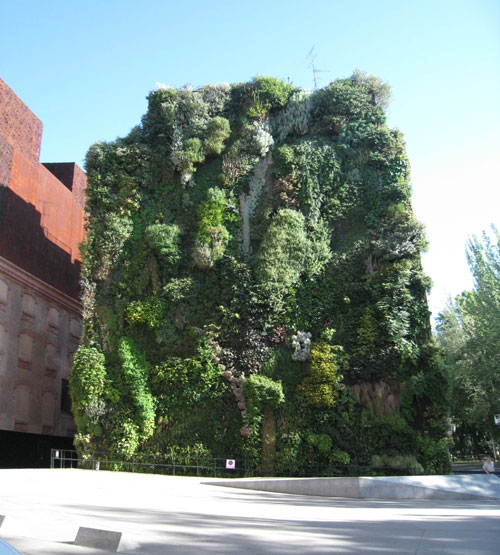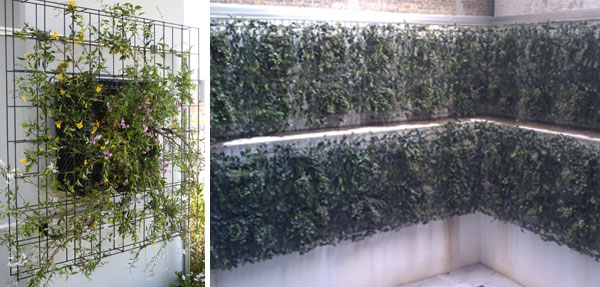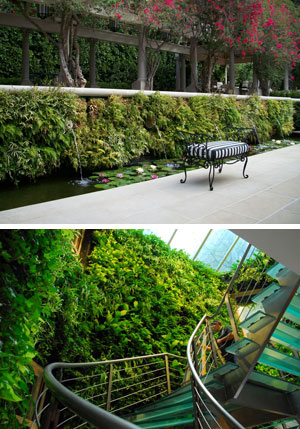Green Walls: Integrating Nature into Buildings
Elsewhere French botanist Patrick Blanc displayed the first “Plant Wall” in 1994 as a true hydroponic system, not dependent on soil as the growing medium for the plants. The same year, the first indoor living wall used for bio-filtration was displayed in Toronto, Canada. And in Japan, the “Bio Lung” became the landmark of the EXPO 2005 Aichi, symbolizing the wisdom of nature by featuring over 300 green wall panels from various systems. It uses 3,500 square meters of vegetated wall systems that are made for the purpose of improving the environment of busy city areas where an enormous amount of CO2 is emitted. Bio Lung was born to introduce plants in these urban areas with densely packed buildings where there is very little or no suitable open space left to grow plants on the ground or other horizontal surfaces.
In this country, the City of Seattle, Washington has been a leader by adopting, in 2007, a program called The Green Factor. As a result, it is now required that all new developments must have 30 percent vegetation coverage, or the functional equivalent (e.g., permeable surfaces in commercially zoned areas). A building applicant, architect or landscape architect chooses from a menu of landscape strategies including large trees, permeable paving, rain gardens, green roofs and green walls, similar to the German Green Area Factor. The main drivers of the program include improving microclimates, reducing the urban heat island effect, maintaining and improving soil function and water quality, and enhancing the quality and quantity of plant and animal habitats.
 |
Recent work such as Patrick Blanc’s hydroponic walls in France show new ways to make green walls viable. Photo courtesy of Tournesol Siteworks LLC |
As the research, development, and application of different types of vegetated wall systems have grown in recent decades, it is important to be clear on the distinctions between these types and the common current nomenclature being used:
- “Green walls” is an all-encompassing term that is used to refer to all forms of vegetated wall surfaces. However, there are two major system categories that fall under this term’s rubric: green façades and living walls. These two terms, as defined below, will be the focus of this article.
- A ‘Green Façade’ (or façade greening), are systems in which climbing plants or cascading groundcovers are trained to grow onto and over specially designed supporting structures. There are two primary types of green façades: modular trellis systems, and cable / rope wire systems. Both of these systems afford a high degree of design flexibility since they can be wall mounted, freestanding, or used as columns. Modular trellis products can be installed vertically in either a wall mounted or freestanding application. Cable/rope wire systems can span long distances, but special or complex designs may defeat the simplicity of the system. Green facades with climbing plants are assembled on site, drawing on common skill sets (e.g., carpentry), virtually eliminating the need for specialized design and installation professionals. Nursery plants are usually planted at the base, sometimes in intermediate planters or on rooftops, and may take some time before growing in to achieve full plant coverage. Pruning and pinching may be required as part of a regular maintenance plan.
 |
A modular trellis hybrid system as part of a green façade. Photos courtesy of Tournesol Siteworks LLC |
- A ‘Living Wall’ is an integral part of an exterior building envelope system or an interior wall. In either case, a living wall is comprised of distinct panels that are either pre-vegetated or planted on site and include growing medium or liquid nutrient. The panels are installed into or on top of a frame and can either be secured to a structural wall or designed to be self-supporting. The living wall panels are typically made of plastic, expanded polystyrene, clay, or concrete and can support a great diversity and density of plant species (e.g., a lush mixture of groundcovers, ferns, low shrubs, perennial flowers and/or edible plants). They can also be used to create stunning and creative visual designs on walls. When used for interior applications, living walls can provide natural bio-filtration of indoor air.
 |
Living Walls can take many different forms, colors, and textures. Photos courtesy of Tournesol Siteworks LLC |
- A ‘Landscape Wall’ is an exterior engineered living structure that is designed to stabilize a slope, while having the advantage of supporting vegetation cover. They provide the structural strength to resist the lateral forces exerted by angles greater than the natural angle of repose of soil and protect the slope against erosion. This type of green wall has also been frequently used for noise attenuation purposes. Since this type of application is not usually affixed to a building, it is pointed out here for clarification, but is not the focus of the remainder of our discussion here.
Regardless of whether a green façade or a living wall is selected, all green walls share many of the same benefits and follow essentially similar design processes.









